“Building telehealth platforms isn’t just about video calls. It’s about delivering personalized, data-driven care that scales across millions of lives — Jason Gorevic, CEO, Teladoc Health”. The cost to develop an app like Teladoc in 2025 can range from 38,500 to $400,000, depending on several factors, including app complexity, development team location, and expertise. Read on.
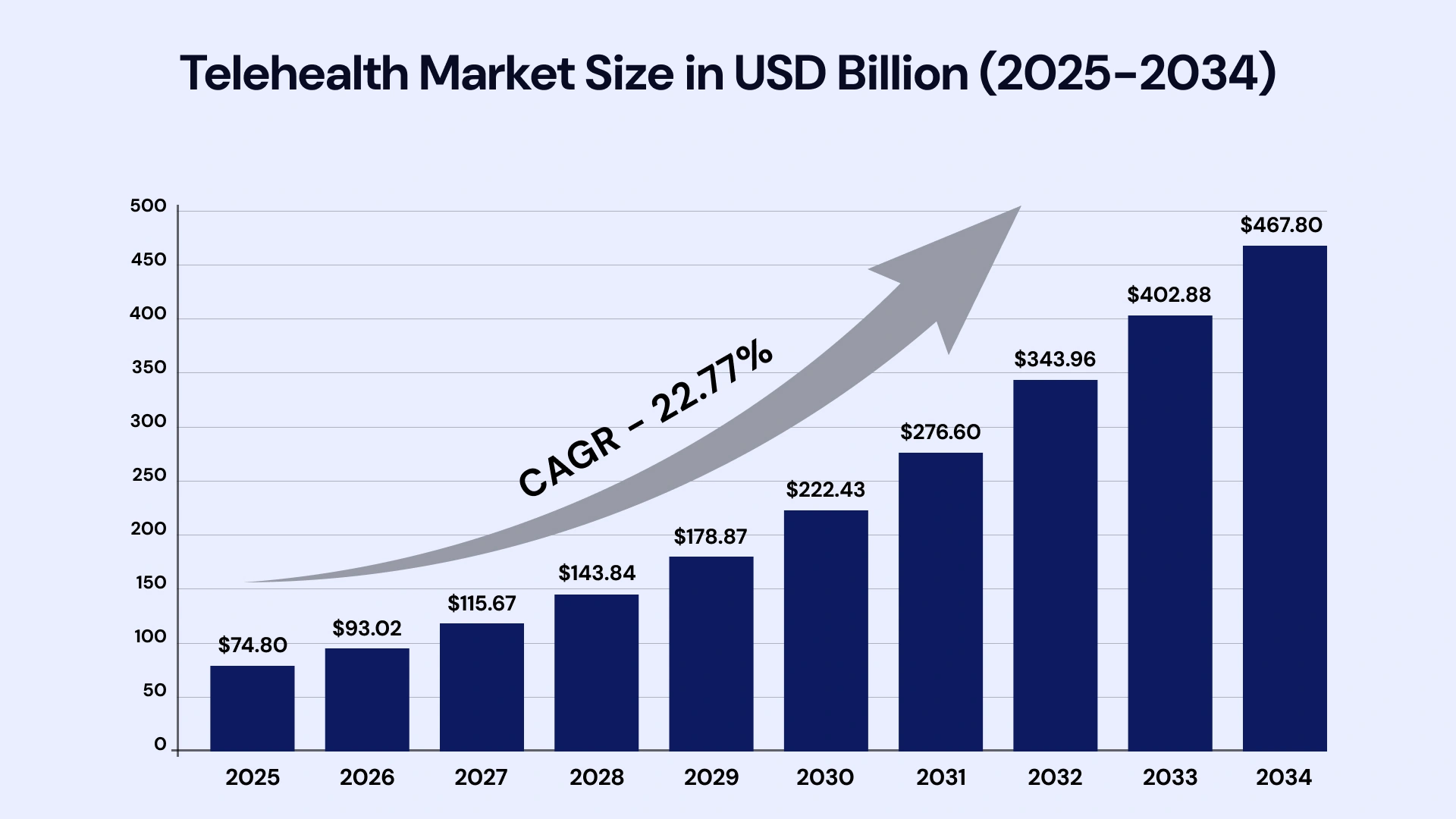
McKinsey & Company estimates that around $265 billion in U.S. healthcare spending could potentially shift to digital channels in the future. That’s why there’s a huge opportunity for businesses planning to invest in digital healthcare platforms.
Suppose you’re a C-suite-level executive thinking about developing a telehealth app like Teladoc. In that case, you probably want to know the most important question: How much does Teladoc app development cost?
On average, Teladoc-like telemedicine app development costs can range anywhere from $38,500 to $400,000, depending on how complex and feature-rich the app is.
In this article, you will discover:
- Factors influencing the cost to develop an app like Teladoc
- Smart strategies to save money without compromising quality
- Hidden costs that many overlook during development
- Tips on how to build an app that outperforms your competitors
Teladoc Health App: Redefining Healthcare Access
Teladoc Health is recognized as one of the world’s most trusted and widely adopted telehealth platforms, delivering virtual care across multiple specialties. It enables patients to consult a wide range of certified doctors, therapists, and medical experts 24/7 via video or phone.
Driven by its mission to make healthcare more accessible and convenient, Teladoc has established a strong global presence, serving over 50 million members across 175 countries.
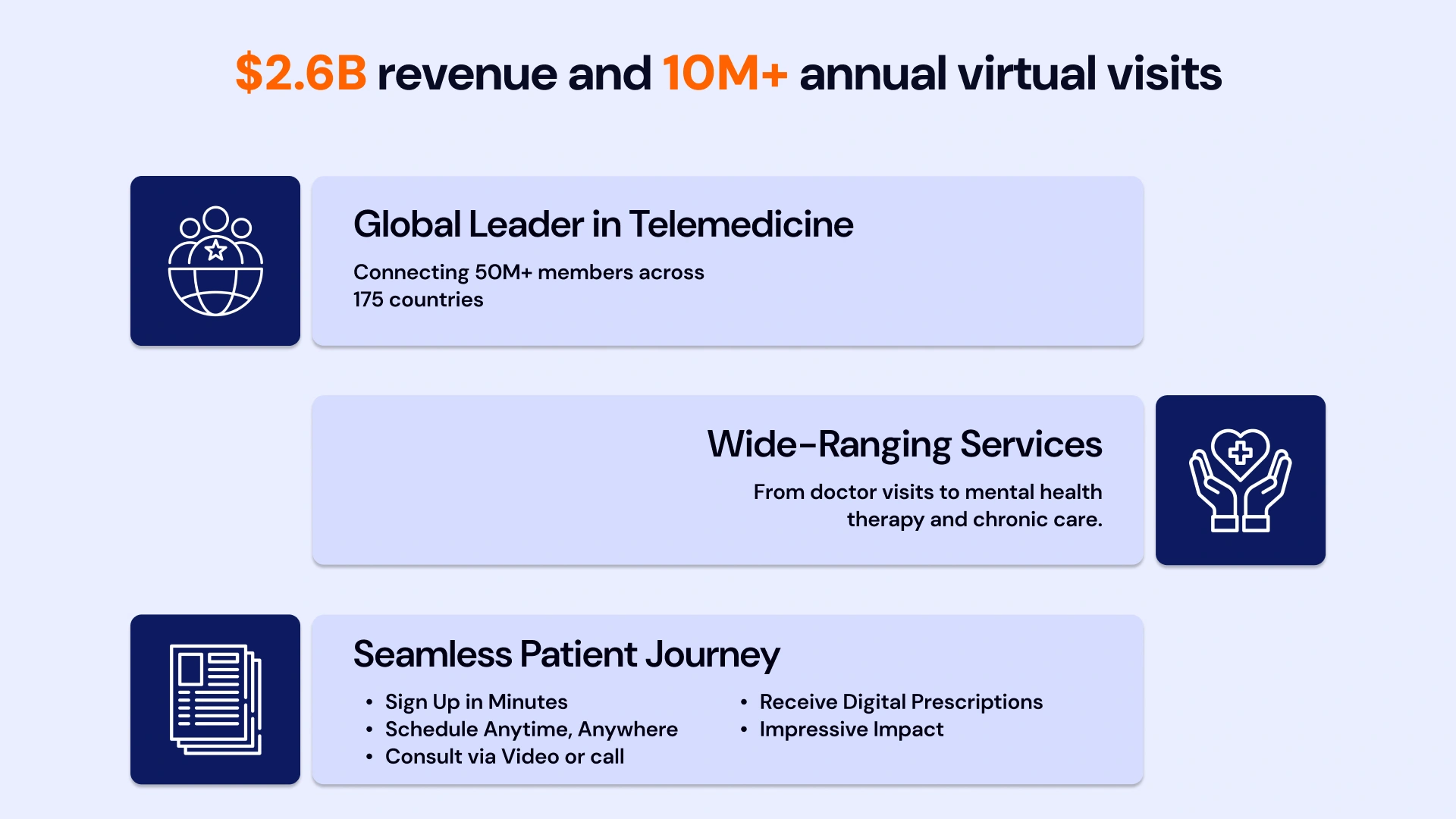
Why Teladoc Sets the Benchmark for Telehealth Apps
Teladoc’s strong financial foundation supports continuous investment in next gen mobile app development technologies such as artificial intelligence, machine learning, and wearable health device integration. These innovations are transforming the way healthcare is delivered and improving patient outcomes.
While incorporating such advanced capabilities may influence the cost to develop an app like Teladoc, they are key to building a next-generation telehealth solution that truly makes an impact.
Several key factors contribute to the success of the Teladoc app:
1. End-to-End Virtual Care Ecosystem
Teladoc offers a fully integrated suite of healthcare software development services across physical and mental health, chronic condition management, and wellness programs—ensuring continuity of care in one seamless platform.
2. Global Scalability and Market Penetration
With operations in 175 countries, Teladoc’s scalable infrastructure and multilingual capabilities position it as a top choice for enterprises and insurers with a global presence.
3. Addressing Healthcare Access and Cost Challenges
By eliminating barriers to timely care, Teladoc helps reduce unnecessary ER visits, lower overall healthcare costs, and improve health outcomes—especially in underserved and remote regions.
4. Seamless Integration with Employers & Payers
Teladoc’s platform is designed to integrate smoothly with employer-sponsored health benefits and insurance plans, driving high user adoption and delivering measurable ROI in population health management.
Given Teladoc’s comprehensive features and large-scale success, many healthcare startups and enterprises are curious about the cost to develop an app like Teladoc.
Let’s explore.
How Much Does It Cost to Build a Telemedicine App Like Teladoc in 2025?
The cost of creating a telemedicine app like Teladoc in 2025 can fall between $38,500 and $400,000. This estimate includes essential telemedicine app development cost factors such as UI/UX design, development team expertise, security features, and third-party API integrations.
The final cost of Teladoc mobile app development varies depending on the app's complexity, the chosen tech stack, and the level of customization required to meet specific business objectives.
Here’s a breakdown of the Teladoc-like telehealth app development cost based on app types and features:
| App Type | Estimated Cost | Average Timeline | Key Features |
| Basic App | $60,000 – $100,000 | 3 – 5 months | - Patient registration - Appointment booking - Basic video consultations |
| Mid-Level App | $100,000 – $200,000 | 5 – 8 months | - EHR integration - In-app chat - Payment gateway - Prescription management |
| Highly Complex App | $200,000 – $300,000+ | 8 – 12+ months | - AI symptom checker - Real-time health monitoring - Analytics dashboard - Multi-user roles - Enterprise-level scalability |
Formula to Determine the Cost to Develop an App Like Teladoc
To estimate the final Teladoc app development cost, it's necessary to follow a structured approach. One commonly used formula is:
Final Development Cost = (Development Hours × Hourly Rate) + 15-20% contingency for unpredictable expenses
This formula ensures that all crucial factors are considered additional expenses for specialized functionalities, including:
Security enhancements,
Scalability improvements,
AI-powered tools
Wearable technology integrations
Factors That Influence the Teladoc-Like Telemedicine App Development Cost
While initial costs may be high, the long-term benefits of a custom telehealth app ensure business success in the growing healthcare market. Let's explore several factors affecting the cost to develop an app like Teladoc in 2025.
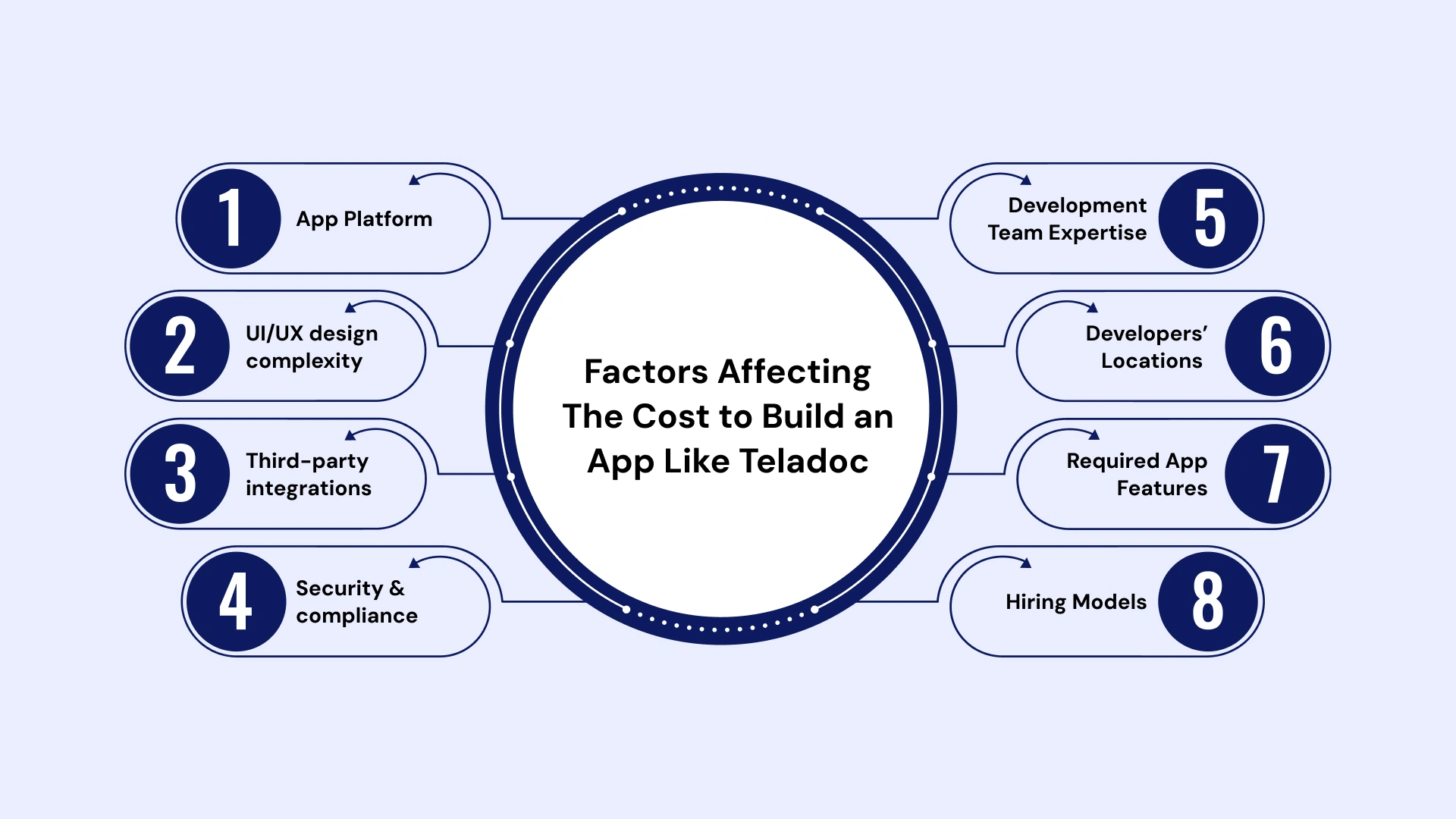
App Platform
Choosing the right platform—iOS, Android, Web, or all three—is critical in determining the overall cost of a Teladoc-like telehealth app development. Creating a single platform (iOS or Android) is relatively cost-effective, typically ranging from $35,000 to $75,000 depending on app complexity.
However, opting for cross-platform development or adding a web-based version increases both time and resources required, potentially raising costs to $75,000–$180,000 or more.
UI/UX Design Complexity
Another factor that influences the cost to develop an app like Teladoc is UI/UX design complexity. A simple layout with minimal visuals is more budget-friendly and quicker to produce. On the other hand, custom designs, animations, and accessibility features can drive up design costs significantly.
While this raises upfront costs, it is critical in user satisfaction, engagement, and retention, especially in a healthcare setting where ease of use is paramount.
Third-Party Integrations
To offer a seamless and feature-rich user experience, integrating third-party services in telehealth apps like Teladoc is essential. These may include:
- Video conferencing APIs (e.g., Twilio, Agora)
- Payment gateways (e.g., Stripe, PayPal)
- Electronic Health Records (EHR) systems
- Pharmacy integrations
- Wearable device data sync
Integration costs can range between $10,500 to $48,000, depending on the number of APIs and the complexity of customization required. For example, implementing a HIPAA-compliant video consultation feature using Twilio can cost $8,000–$15,000.
Security & Compliance
Security is a non-negotiable requirement for telemedicine apps. You must comply with healthcare regulations like HIPAA, GDPR, and PIPEDA.
This includes data encryption, secure login (MFA), access control, audit logs, and safe cloud storage practices.
Ensuring HIPAA or GDPR compliance can cost between $15,000 to $50,000, depending on your app architecture and third-party services. Regular security audits also add ongoing maintenance costs.
Development Team Expertise
One of the most critical factors that significantly influences the cost to develop an app like Teladoc is dedicated development team. Robust and secure telehealth app development requires a cross-functional team of experts.
Let’s explore the key team members, their responsibilities, and estimated total cost based on Teladoc like telehealth app development needs:
| Team Role | Key Responsibilities | Estimated Total Cost (USD) |
| Project Manager | Oversees planning, timelines, and team coordination | $8,000 – $15,000 |
| UI/UX Designer | Designs intuitive and patient-friendly interfaces | $5,000 – $10,000 |
| Frontend Developer | Builds the patient and doctor-facing app interface | $10,000 – $25,000 |
| Backend Developer | Develops server-side logic, database integration, APIs | $15,000 – $30,000 |
| Mobile App Developer | Builds Android/iOS apps (native or cross-platform like Flutter) | $12,000 – $30,000 |
| DevOps Engineer | Manages cloud deployment, CI/CD pipelines, app scalability | $5,000 – $12,000 |
| QA Engineer | Conducts testing, bug tracking, performance testing | $4,000 – $8,000 |
| Healthcare Compliance Expert | Ensures HIPAA compliance, data encryption, and privacy laws are met | $5,000 – $10,000 |
| Business Analyst | Defines app requirements, conducts market and competitor research | $3,000 – $7,000 |
| Support & Maintenance Team | Ongoing updates, bug fixes, user support | $2,000 – $5,000/month |
Region of Developers
When it comes to hiring a development team, their location influences the cost to develop an app like Teladoc. Development in the US and Canada charge premium rates. On the other hand, mobile app developers in India and Eastern Europe offer cost-effective solutions with comparable quality.
Let’s explore the cost breakdown of telehealth app development based on location of developers:
| Region | Estimated Development Cost (USD) |
| United States | $180,000 – $300,000 |
| Canada | $160,000 – $280,000 |
| Eastern Europe (e.g., Ukraine, Poland, Romania) | $90,000 – $160,000 |
| India | $50,000 – $120,000 |
| Middle East (e.g., UAE, Egypt) | $80,000 – $150,000 |
Hiring Models
Choosing the right hiring model is a critical cost-driving factor when building a telehealth app like Teladoc. Each hiring approach—outsourcing staff augmentation or in-house development—impacts the overall teladoc app development cost, timelines, and quality of outcomes.
Outsourcing is a model where the entire development process is handed over to an external agency or third-party vendor. In-house model allows organization hires and manages its own full-time team to handle the development internally.
On the other hand, staff augmentation is a flexible model where external developers are temporarily added to the internal team to fill skill gaps or scale faster.
Here is a cost breakdown of hiring models to build a telehealth app like Teladoc:
| Hiring Model | Estimated Cost Range (USD) |
| Outsourcing | $40,000 – $120,000+ |
| In-House | $150,000 – $300,000+ |
| Staff Augmentation | $80,000 – $180,000+ |
Required App Features
The number and complexity of features you include will be a major cost driver. A basic MVP for Teladoc like app development may include:
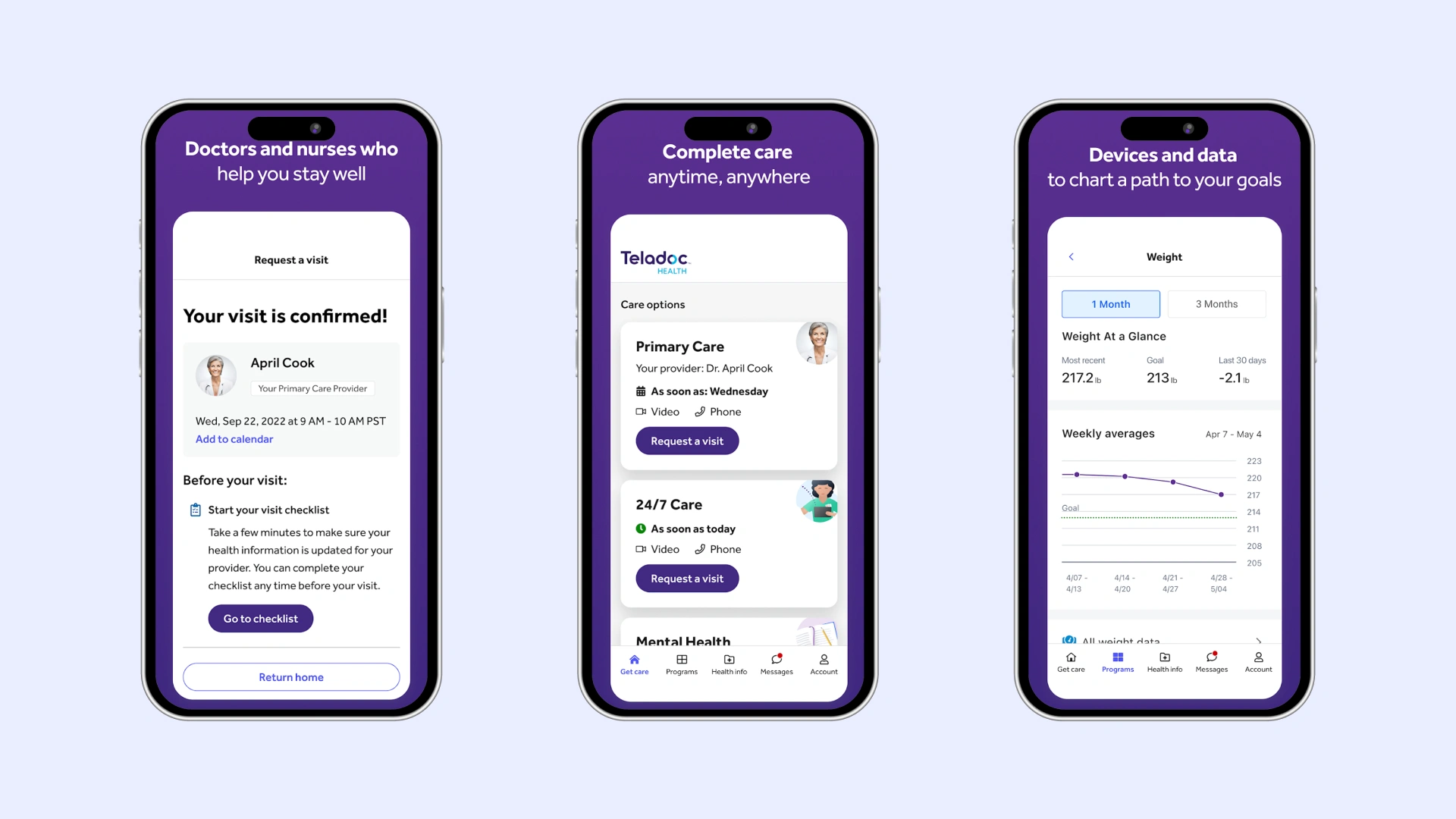
- Patient registration & profiles
- Appointment booking/scheduling
- Video/audio consultation
- e-Prescriptions
- Chat support
- Payment integration
- Push notifications
- Doctor dashboard
At VLink, we have built a unified dashboard that delivers real-time reports and smarter decisions—all on one platform. Explore our case study!
Here is a cost breakdown of Teladoc like telehealth app development based on key features:
| Feature | Estimated Cost Range |
| User registration/login | $5,000–$10,000 |
| Video consultations | $10,000–$25,000 |
| Calendar & appointment | $6,000–$12,000 |
| EHR integration | $10,000–$20,000 |
| Admin panel | $8,000–$15,000 |
| Chat & notifications | $5,000–$10,000 |
| Payment processing | $3,000–$7,000 |
| e-Prescriptions | $6,000–$12,000 |
A fully featured version of Teladoc could easily cross $150,000 to $300,000 based on advanced features like AI-based symptom checking, wearable data integration, or multilingual support.
Must-Have Telehealth App Features
When developing a telehealth app like Teladoc, it’s important to integrate features that meet the diverse needs of both healthcare providers and patients. A well-balanced telehealth application should offer intuitive experiences on both the doctor and user sides.
The cost to develop an app like Teladoc mostly varies depending on the features mentioned below:
Doctor Side Panel
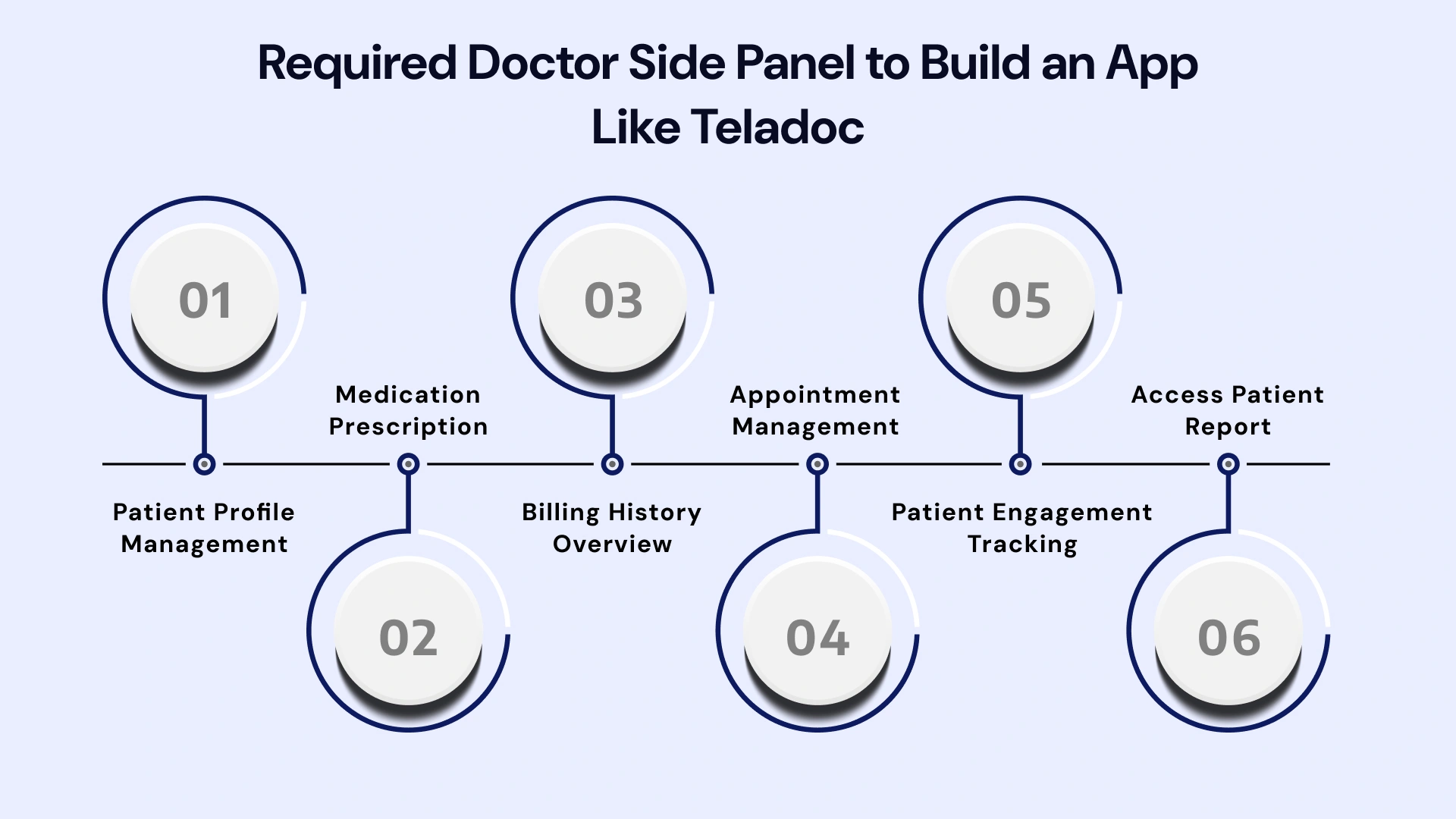
Patient Profile Management: This feature allows doctors to view and update patient records, medical history, symptoms, and past interactions in one place.
Medication Prescription: With this feature, doctors can digitally prescribe medicines and send prescriptions directly to patients or connected pharmacies.
Billing History Overview: It enables healthcare service providers to access each patient's previous consultation fees, payment status, and financial records.
Appointment Management: Doctors, nurses, or clinicians can schedule, reschedule, or cancel appointments while managing availability and calendar sync.
Patient Engagement Tracking: This feature allows healthcare service providers to monitor patient behavior, such as missed appointments, follow-up adherence, or treatment response.
Access Patient Reports: Doctors can review lab test results, imaging, or uploaded reports before or during consultation thanks to access patient reports features.
User Side Panel
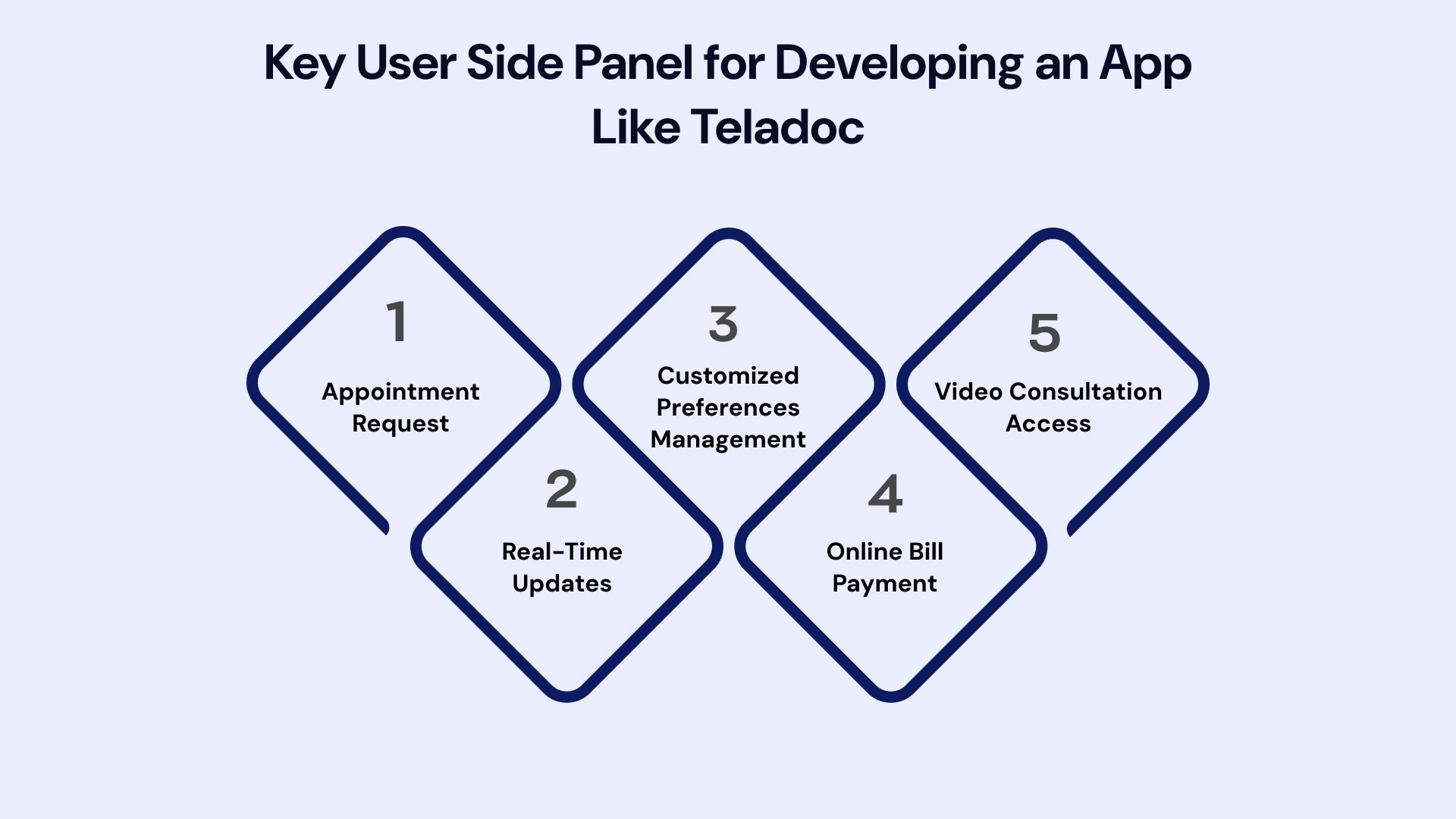
Appointment Request: With this feature, patients can book consultations with preferred doctors by checking their availability and expertise.
Real-Time Updates: Thanks to this feature, patients can get instant notifications for appointment confirmations, prescription updates, and doctor messages.
Customized Preferences Management: Patients can tailor their experience by selecting their preferred language, consultation mode (chat, video, or voice), and notification settings.
Online Bill Payment: Now, patients can securely pay consultation fees through integrated payment gateways (UPI, card, net banking) thanks to the online bill payment feature.
Video Consultation Access: These features enable patients to connect with doctors through high-quality, HIPAA-compliant video calls.
What is the Hidden Cost to Develop an App like Teladoc?
The upfront costs such as UI/UX design, core feature development, and compliance integrations are easy to calculate. Businesses often overlook hidden fees that can significantly impact the total investment. Here are some of the most common hidden costs to consider:
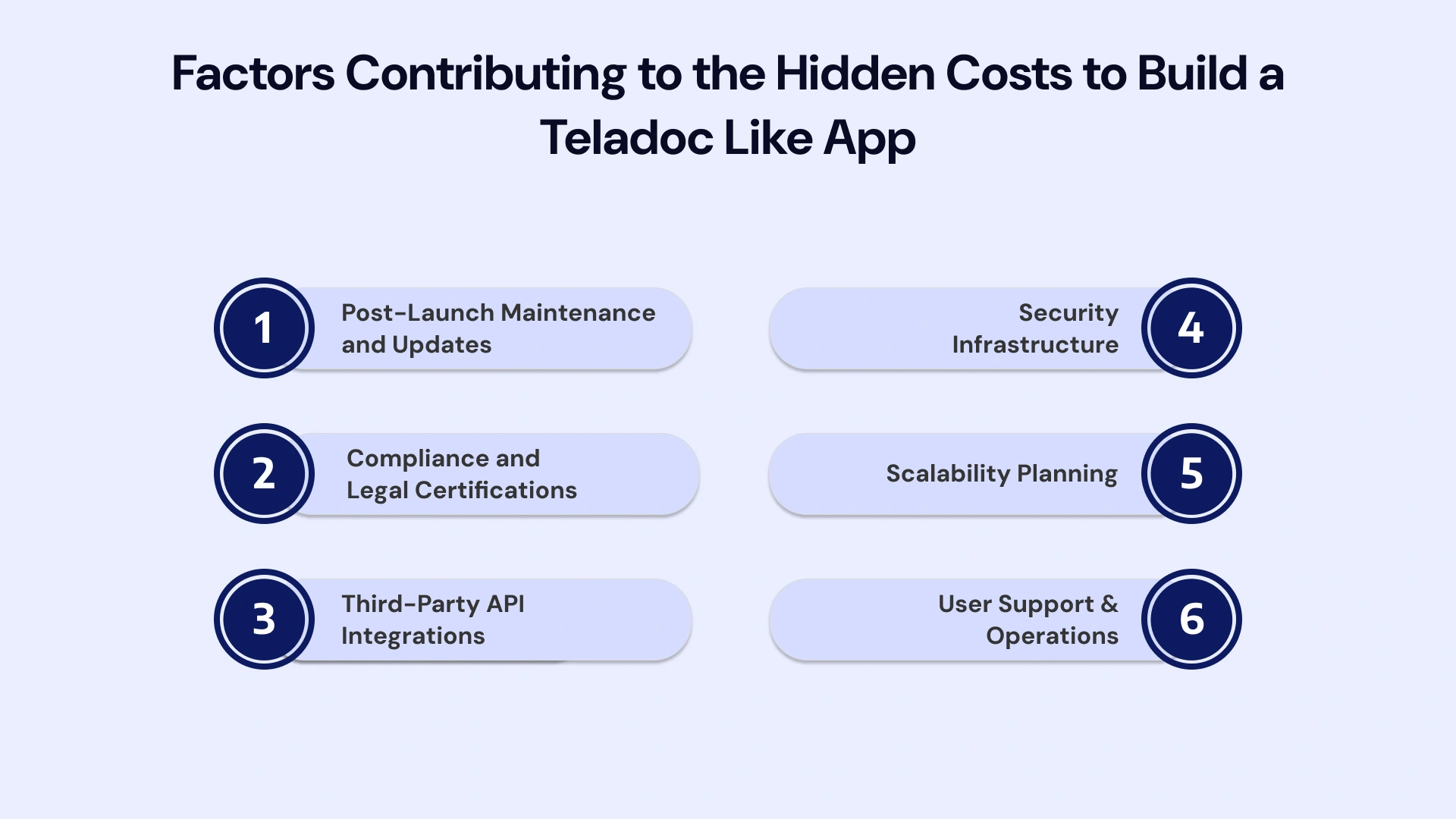
1. Post-Launch Maintenance and Updates
Telehealth apps like Teladoc require regular updates for new OS versions, feature enhancements, security patches, and performance improvements. Failing to invest in post-launch maintenance can lead to app crashes, reduced user trust, and regulatory risks.
Estimated Cost: Annual cost is 15–20% of the initial healthcare app development cost.
2. Compliance and Legal Certifications
Beyond HIPAA, your app may need to comply with GDPR, HL7, or region-specific healthcare regulations. Acquiring these certifications requires legal consultations and audits, which often go unplanned in initial budgeting.
Estimated Cost: $5,000–$25,000+ depending on regions served.
3. Third-Party API Integrations
Features like video calls, e-prescriptions, payment gateways, and EHR integrations often depend on third-party APIs that charge based on usage. These recurring charges can add up as the user base grows - $500–$3,000+ monthly
4. Security Infrastructure
Advanced cybersecurity services Multi-factor authentication, end-to-end encryption, intrusion detection systems, and regular penetration testing are crucial for patient data protection but come with added costs.
Estimated Cost: $10,000–$50,000 annually.
5. Scalability Planning
As your user base grows, your infrastructure must scale—requiring investment in cloud services, load balancers, and performance optimization tools. Without early planning, scaling up later may incur downtime and higher costs.
Estimated Cost: Varies by user base; typically, $2,000–$10,000/month for cloud hosting and infrastructure.
6. User Support & Operations
24/7 patient support, physician onboarding, appointment rescheduling, and handling medical queries often need human support, chatbots, or CRM integrations.
Estimated Cost: $1,000–$5,000/month, depending on automation and staffing.
To avoid surprises, work with a telehealth app development company that offers transparent pricing and helps forecast long-term costs.
Proven Strategies to Reduce Your Teladoc App Development Costs
Developing a feature-rich telehealth app like Teladoc can be expensive, but smart strategies exist to control and reduce costs without compromising quality. Here’s how you can reduce the cost to develop an app like Teladoc:
1. Start with an MVP: Focus on building only the core features—such as video consultations, appointment scheduling, and secure messaging—in the initial phase. Building an MVP allows you to validate your idea faster and minimize upfront on-demand doctor app development pricing, often cutting them by 30–50%.
2. Choose the Right Development Partner: Hiring experienced developers or outsourcing to a reliable app development company in cost-effective regions (like India or Eastern Europe) can significantly reduce your budget by up to 60% compared to US-based developers.
3. Use Pre-Built Telehealth App Components: Instead of building everything from scratch, integrate ready-made modules like;
- Payment gateways
- Chat APIs (e.g., Twilio)
- Video SDKs (e.g., Agora).
This cost factor reduces time-to-market and development efforts by 20–30%.
4. Leverage Cross-Platform Development: Use cross-platform frameworks like Flutter or React Native to build one codebase for Android and iOS platforms. It also lowers Teladoc app development cost and time by up to 40%.
5. Implement Agile Methodology: Agile development ensures flexibility, faster delivery, and regular feedback, reducing the chances of costly rework. These hidden cost factors help avoid budget overruns and improve ROI.
Following these strategies, you can build a high-performing telehealth app like Teladoc while staying within budget. For expert guidance and affordable solutions, consult a trusted telemedicine app development company for your projects.
How to Make Your Telehealth App Superior to Teladoc?
Teladoc may be one of the leading names in the telehealth industry, but even top players have room for improvement. If you plan to invest in virtual care app development, consider this an opportunity to innovate—not just replicate.
By addressing common user complaints and integrating next-gen features, you can build a telehealth app superior to Teladoc. While exploring the cost to develop an app like Teladoc, these enhancements can help you deliver more value, improve user retention, and gain a competitive edge in the growing digital healthcare market.
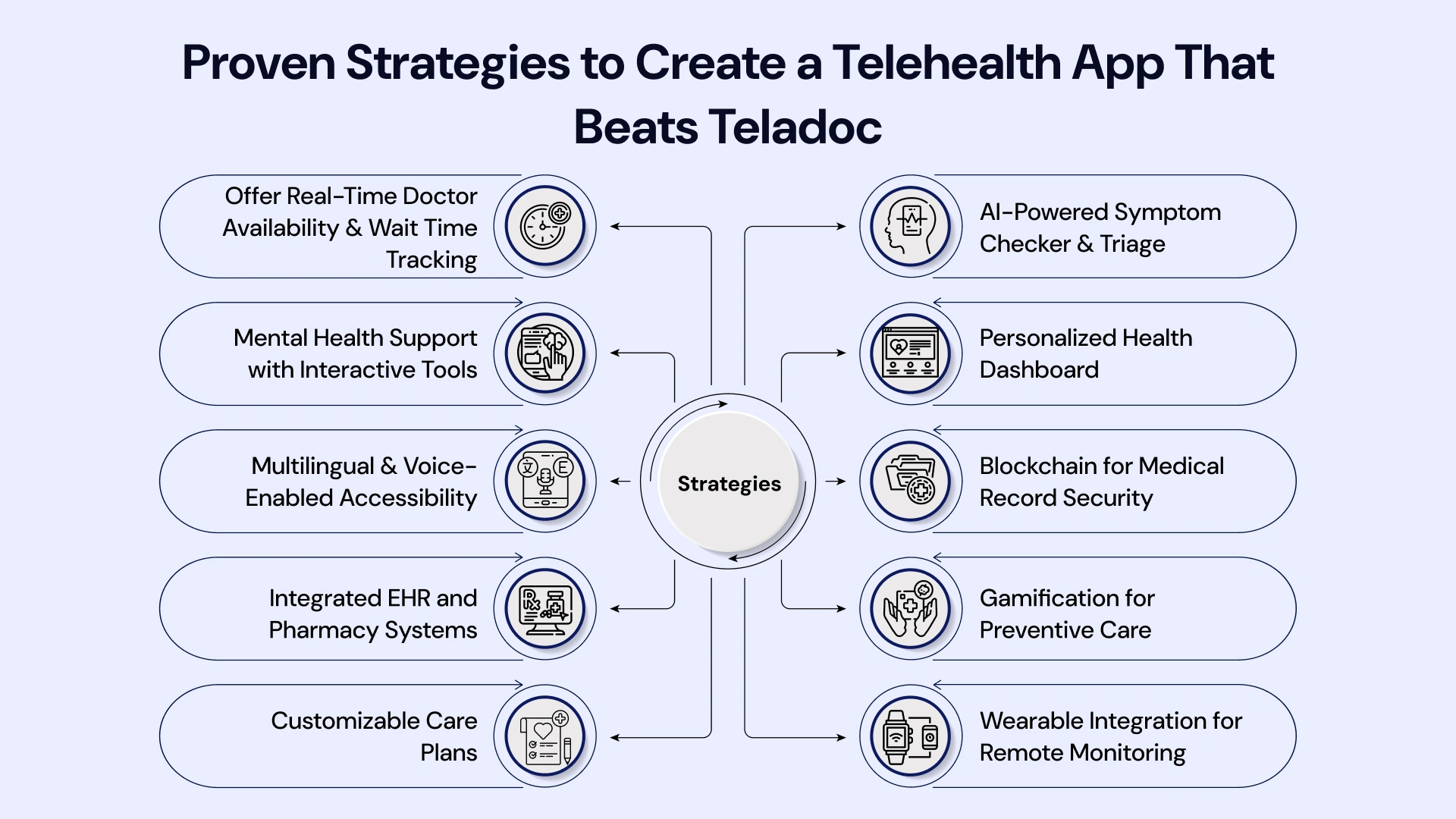
Offer Real-Time Doctor Availability & Wait Time Tracking
Long wait times and the lack of transparency around doctor availability often make the user experience frustrating on apps like Teladoc. Patients are left waiting without clear updates, which can feel stressful—especially when immediate care is needed.
You can eliminate this uncertainty by integrating real-time doctor availability tracking and dynamic wait-time estimates into your app. These features empower users to choose doctors based on availability, wait time, or ratings—delivering a smoother, faster, and more reliable experience that outperforms Teladoc.
While adding such advanced features may slightly increase your telemedicine app development cost, the long-term benefits in user satisfaction, retention, and competitive advantage make it a smart investment.
AI-Powered Symptom Checker & Triage
One key area where Teladoc falls short is the lack of advanced pre-consultation support, often leading to unnecessary or misrouted appointments. This can waste time of both patient and provider, ultimately reducing users' satisfaction.
Integrating an AI-powered symptom checker and triage system into your telehealth app allows you to guide users through a quick and intelligent assessment of their symptoms before they even book a consultation.
This feature makes your app more efficient, user-friendly, and superior to Teladoc.
Mental Health Support with Interactive Tools
While Teladoc offers mental health support, it tends to be transactional, with limited engagement between sessions. To provide a more holistic experience, mental health app could integrate mood-tracking tools, journaling prompts, guided meditations, and even AI-based CBT (Cognitive Behavioral Therapy) modules. This creates an interactive support system that extends beyond scheduled therapy sessions.
Personalized Health Dashboard
Teladoc lacks strong post-consultation engagement and health-tracking features, which limits the ongoing value it provides to users beyond virtual visits. To make your app stand out, you can introduce a personalized health dashboard that displays;
- Users' health trends
- Medication schedules
- Vital signs through wearable integration
- Customized wellness tips
This keeps users involved in their health journey and promotes preventive care rather than reactive treatment. While it may slightly raise the cost to develop an app like Teladoc, the boost in user retention, health outcomes, and satisfaction makes it worth the investment.
Multilingual & Voice-Enabled Accessibility
Teladoc offers limited language support and accessibility features, which can be a barrier for non-English speakers, the elderly, and users with disabilities. To make your app more inclusive and user-friendly, consider integrating:
- Multilingual user interfaces
- Voice-enabled commands for navigation
- Screen reader support for visually impaired users
While these features may slightly influence the cost to develop an app like Teladoc, they significantly expand your app’s reach and improve patient outcomes through better usability and accessibility.
Blockchain for Medical Record Security
Data privacy remains a growing concern among Teladoc users, especially concerning rising biggest cybersecurity threats. To build greater trust and offer enhanced security, you can implement:
- Blockchain-based storage for medical records
- Tamper-proof data sharing
- User-controlled access through smart contracts
While this may increase Teladoc app development costs, it’s a valuable investment for ensuring HIPAA compliance and building user confidence.
Integrated EHR and Pharmacy Systems
Many Teladoc users report issues with prescription sync and fragmented follow-up care. You can solve this by enabling seamless integration with:
- Electronic Health Record platforms
- National and local pharmacy systems
- Lab and diagnostics partners
This ensures a true end-to-end care experience, where prescriptions, test results, and referrals are all managed within a cohesive ecosystem.
Gamification for Preventive Care
Teladoc lacks features that engage users outside of consultations, making it difficult to encourage healthy lifestyles. You can increase daily interaction and build long-term loyalty by introducing the following:
Health and fitness challenges
Reward systems for goal completion
Habit trackers and reminders
Gamification boosts user engagement and supports preventive healthcare by promoting consistent healthy routines. While it may increase the cost to develop an app like Teladoc, the payoff in user retention and brand loyalty makes it more worthwhile.
Customizable Care Plans
Teladoc delivers standard care without much personalization, which can feel generic to users. Differentiate your app by allowing users to:
Create or receive tailored care plans.
Set goals based on individual conditions or lifestyles
Adjust care steps based on feedback and progress.
Personalized care boosts patient satisfaction and gives your app a more modern, user-centric appeal.
Wearable Integration for Remote Monitoring
Teladoc provides limited integration with health wearables, restricting real-time monitoring of chronic care patients. Enhance your app like MyFitnessPal by connecting it with devices like Fitbit, Apple Watch and other bluetooth-enabled health trackers.
This enables continuous tracking of vital signs such as heart rate, blood pressure, or glucose levels, making your app more effective for managing chronic conditions like diabetes or hypertension. While this feature may slightly raise the cost to develop an app like Teladoc, it adds significant value for long-term care and user engagement.
How to Build an App Like Teladoc - Step-by-Step Guide
Creating a telehealth app like Teladoc requires a structured development process that ensures regulatory compliance, a seamless user experience, and robust tech integration. Let’s break down telemedicine app development costs based on development phases, purpose, timeline, and average costs.
| Development Stage | Key Activities | Estimated Duration | Estimated Cost (USD) |
| 1. Market Research & Planning | Analyze the telehealth market, define your target audience (e.g., chronic care patients, mental health, general consultations), and finalize core features. | 2–3 weeks | $2,000 – $5,000 |
| 2. Regulatory Compliance Setup | Ensure HIPAA, GDPR, and other local telemedicine regulations are followed. Consult healthcare compliance experts. | 2–3 weeks | $3,000 – $7,000 |
| 3. UI/UX Design | Design intuitive interfaces for patients and doctors, wireframes, and prototypes focusing on easy navigation and accessibility. | 3–4 weeks | $5,000 – $10,000 |
| 4. Development (Frontend + Backend) | Build core modules: user authentication, video conferencing, appointment scheduling, EHR integration, chat, payment gateway, admin dashboards. | 3–6 months | $40,000 – $100,000+ |
| 5. Third-Party Integrations | Integrate services like Twilio (video), Stripe/PayPal (payments), wearable device APIs, and e-prescription tools. | 2–3 weeks | $5,000 – $15,000 |
| 6. Testing & QA | Conduct manual and automated testing for UI, performance, device compatibility, and HIPAA compliance. | 3–4 weeks | $3,000 – $8,000 |
| 7. Deployment | Launch the app on iOS, Android, and/or web. Configure cloud infrastructure (AWS, Azure) and set up CI/CD pipelines. | 1–2 weeks | $1,000 – $3,000 |
| 8. Ongoing Maintenance & Updates | Address bugs, release updates, ensure cybersecurity, and introduce new features based on user feedback. | Ongoing | $2,000 – $10,000/month |
Monetization Models: How to Make Money from Your Teladoc-Like App
Building a telehealth app like Teladoc is not just about providing virtual care—it’s also about creating a sustainable revenue stream. Here are the most effective monetization strategies you can implement to generate profits from your telemedicine platform:
1. Subscription-Based Model: Offer patients monthly or yearly subscription plans, giving them access to a set number of consultations or 24/7 medical support. For example, Teladoc charges users a flat monthly fee for unlimited virtual doctor visits.
2. Pay-Per-Consultation: Patients pay a fixed fee per visit, especially for one-time or on-demand medical consultations.
3. Freemium Model: Allow users to access basic services for free and charge for advanced features like specialist consultations, personalized reports, or wellness coaching.
4. B2B Licensing: License your platform to clinics, hospitals, or insurance providers. They use your white-labeled solution to serve their patients under their brand.
5. Commission from Doctors: Charge a percentage or flat fee from healthcare providers for every successful consultation booked through the app.
6. Pharmacy & Lab Integrations: Partner with pharmacies and diagnostic labs to offer medicine delivery or lab test bookings—and earn a commission per transaction.
7. In-App Advertisements (Selective): Run non-intrusive, health-related ads from pharmaceutical brands or wellness products within the app.
Choosing the right monetization model depends on your target audience and mobile app development service offerings. Successful telehealth apps like Teladoc use hybrid models, combining subscriptions, pay-per-use, and B2B licensing to maximize revenue potential. Implementing a profitable strategy helps you recover the cost to develop an app like Teladoc faster and ensures long-term sustainability.
Choose VLink to Build a Telehealth App Like Teladoc
If you want to launch a next-gen telehealth solution like Teladoc, VLink is your ideal technology partner. With proven experience developing HIPAA-compliant healthcare platforms, we help healthcare startups and enterprises bring smart virtual care apps to life.
We have built a robust mobile app for online doctor consultation for our healthcare client that enables 24/7 access to healthcare via video, phone, or chat, along with features like;
- Appointment scheduling
- Secure medical record storage
- AI-powered health tracking
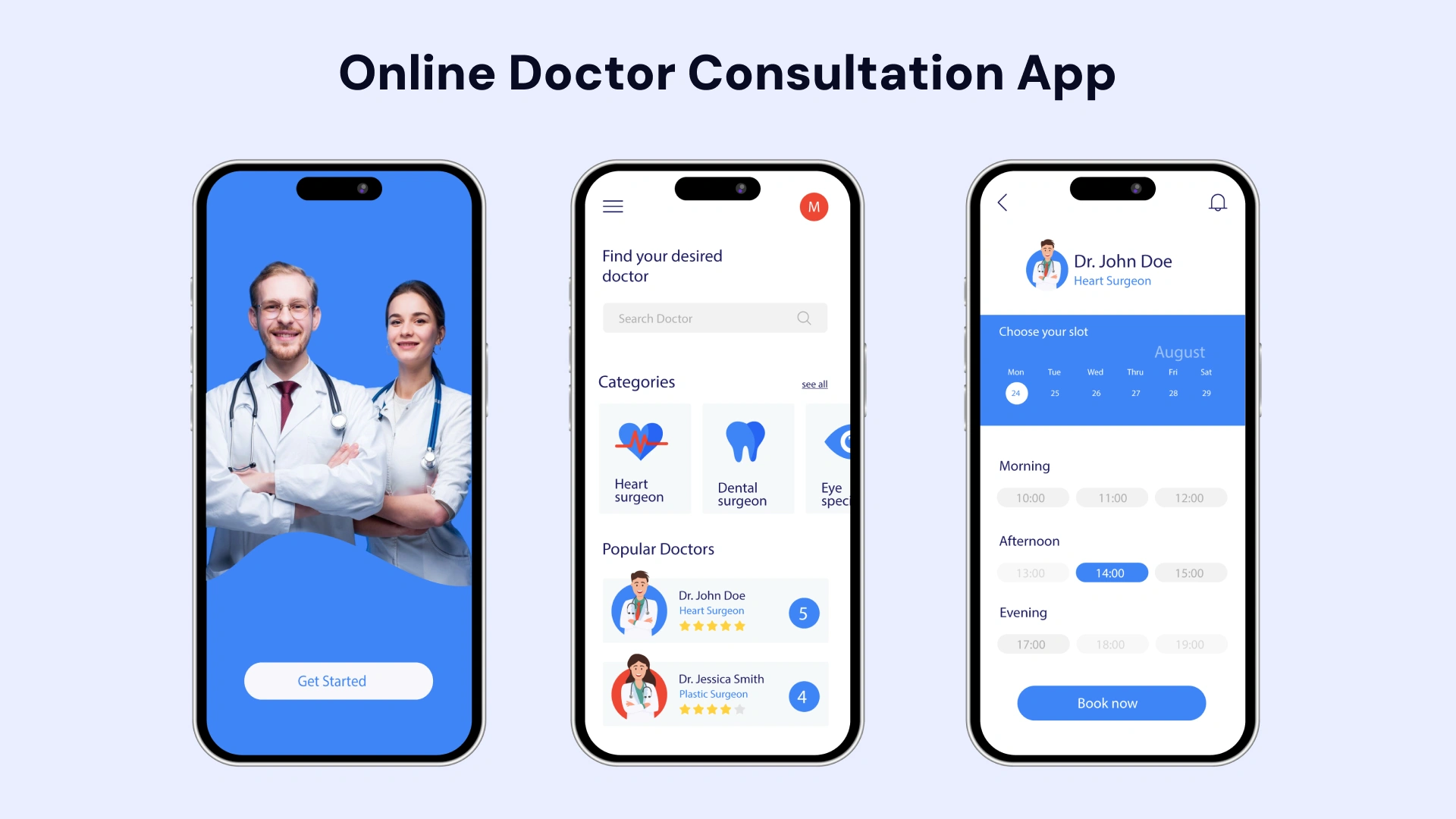
As a result, our client saw a 60% increase in patient engagement, a 40% reduction in appointment no-shows, and faster chronic disease tracking.
Schedule a call to get a quote If you want to know the cost to develop an app like Teladoc.
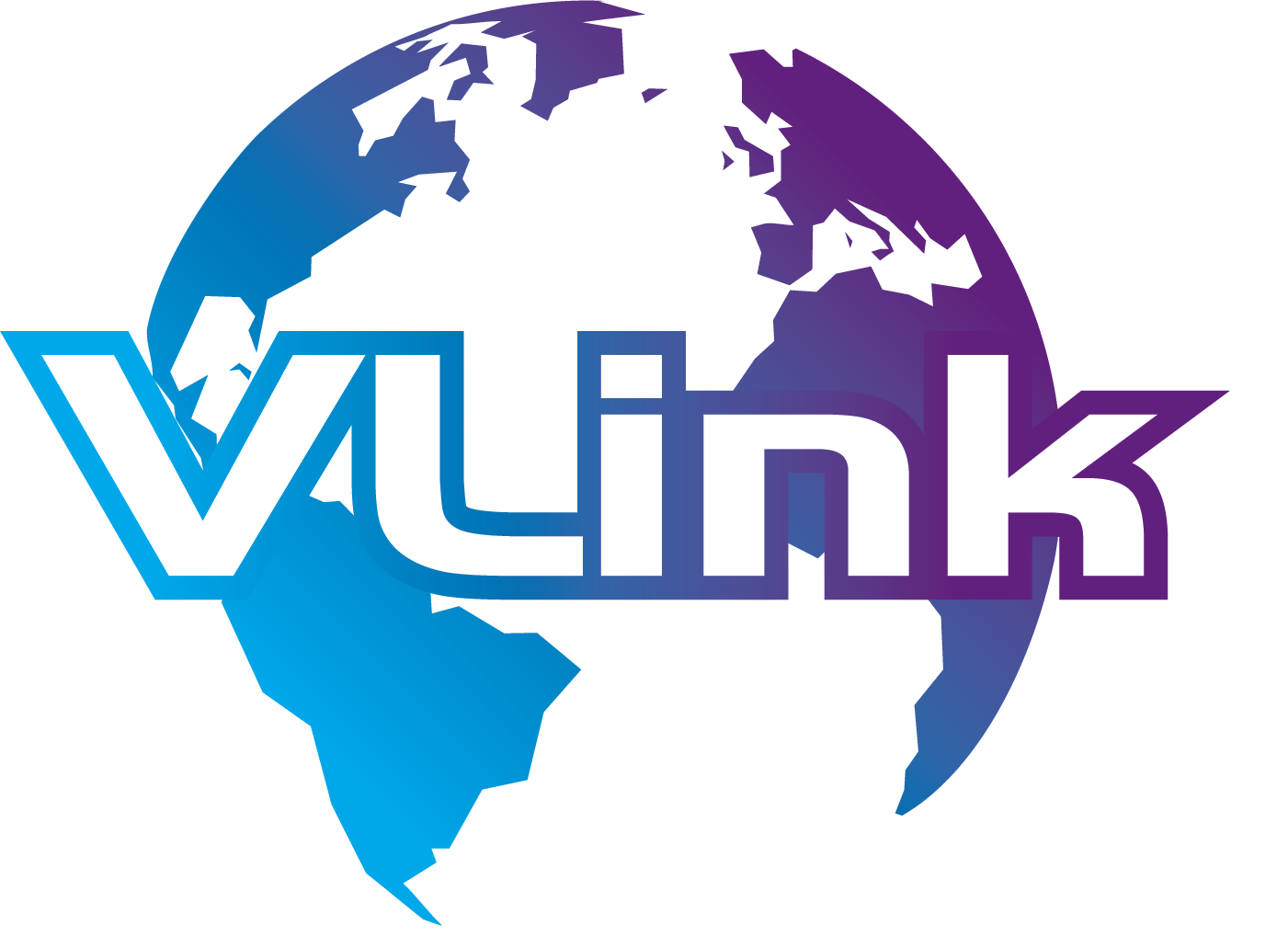










 Shivisha Patel
Shivisha Patel











